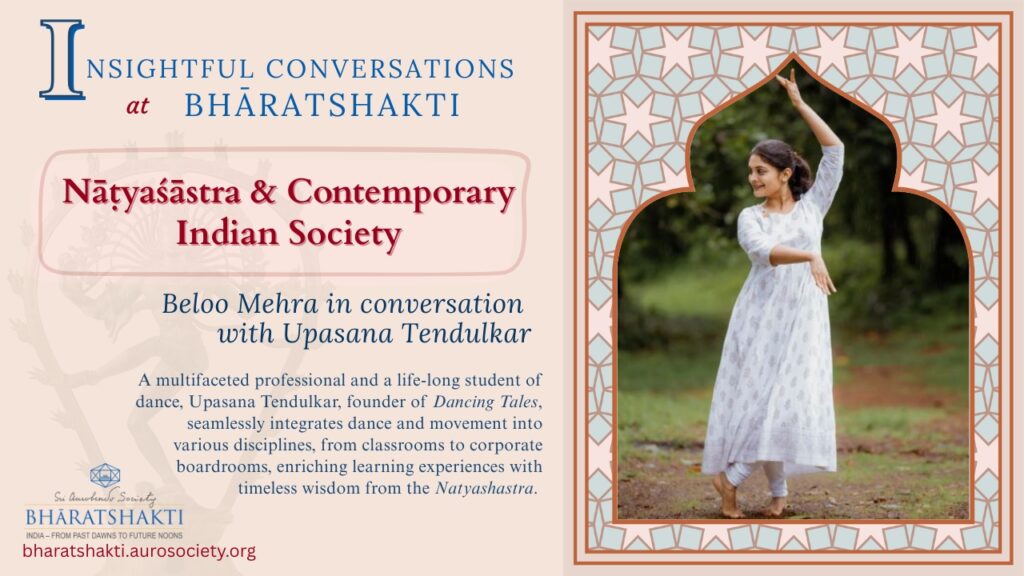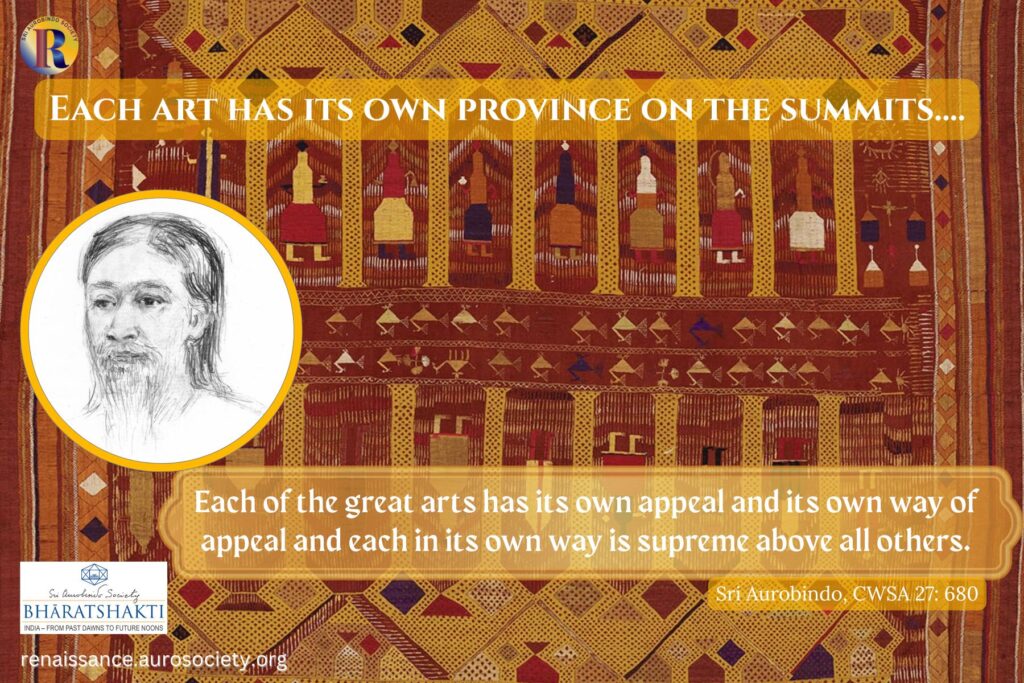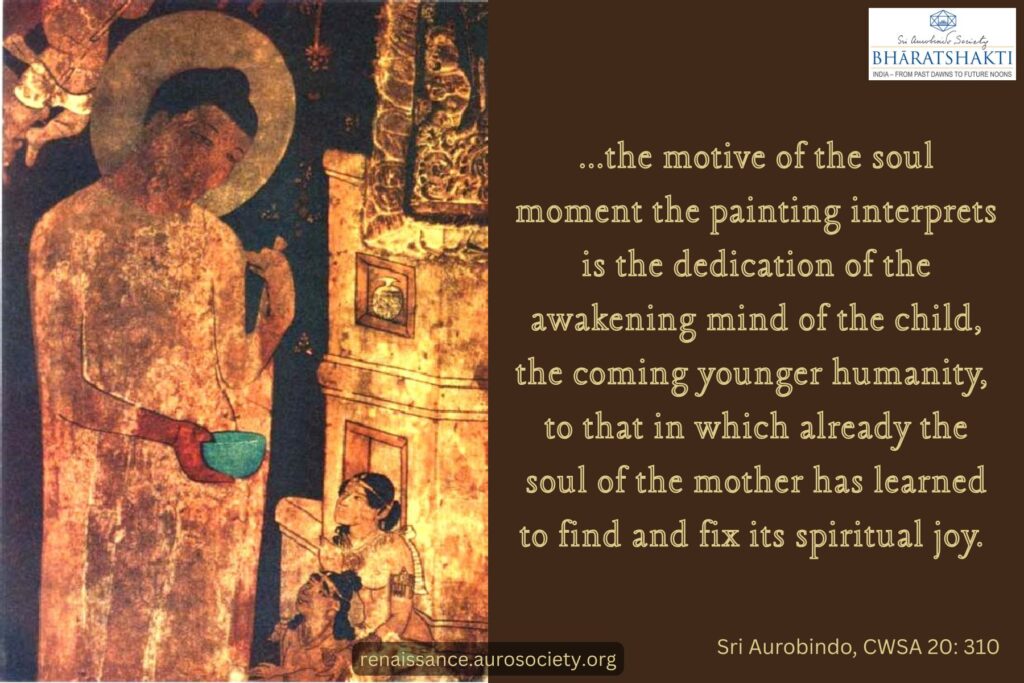Volume VI, Issue 6
Author: Sisirkumar Ghose
Continued from Part 2

Thus arises the hope to replace by realised dreams the memory of her lost memory [like] “temples hewn as if by exiled gods / To imitate their lost eternity” (Sri Aurobindo, Savitri, p. 378). All man’s offerings are at the altar of that temple that is for ever building.
To a deeper view the body itself is that temple, and for those with such realisation the need for fixed rituals is over. This is another freedom or inner fullness offered by art at its highest. And those who realise this freedom and fullness do not, necessarily, dissolve or break away. Rather they unite the opposites, the life of action and the inner life come together, a seamless reality:
… on meditating peaks
Where life and being are a sacrament
Offered to the Reality beyond…~ Sri Aurobindo, Savitri, p. 191
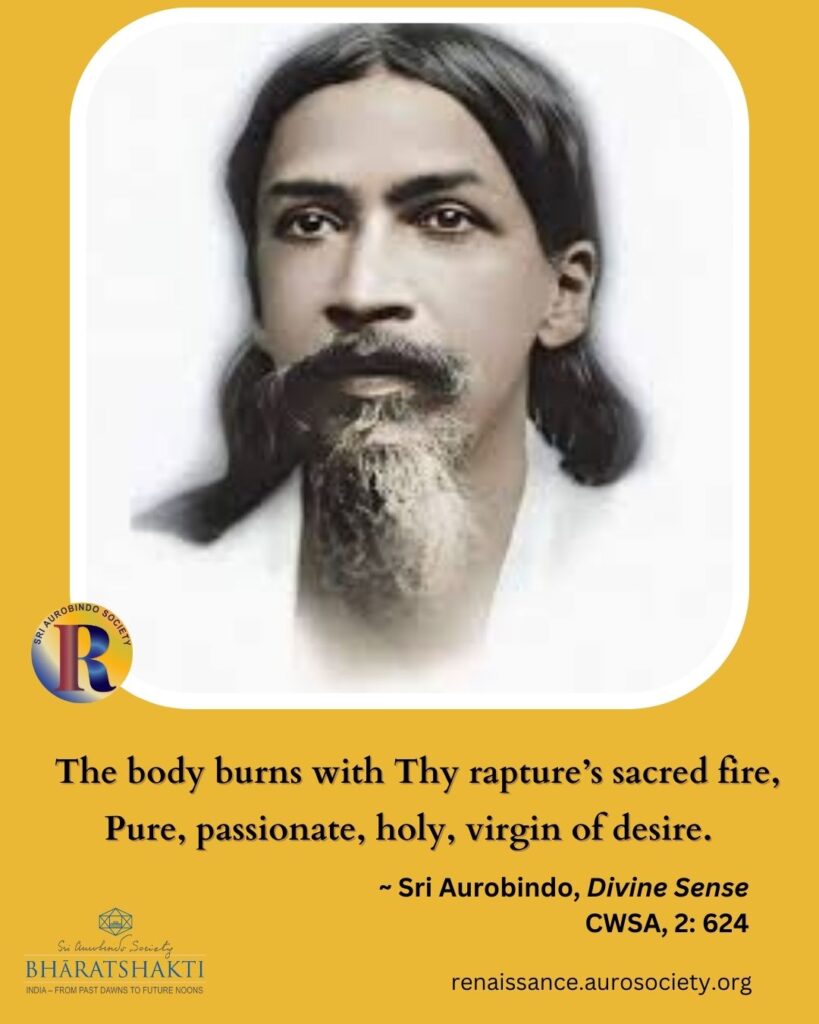
The body burns with Thy rapture’s sacred fire,
Pure, passionate, holy, virgin of desire.~ Sri Aurobindo, Divine Sense, CWSA, Vol. 2, p. 624
In that “sacred fire”, “ever-burning Revelation’s fire”, all dross is destroyed. Every act and movement is lighted up and, as we have said earlier, the need for external worship or bahyapuja is no longer binding. An art of open and universal worship, sacramental attitude is among the promises of the growing psychic or aesthetic life. For “In my heart’s chamber lives the unworshipped God.” (Sri Aurobindo, Omnipresence, CWSA, Vol. 2, p. 620).
Now each finite thing one sees is but a facade or mask of the reality beyond. As the scales fall there comes to view “the divinity of a symbol universe” (Savitri, p. 176), “these yet unimagined harmonies, The fate and privilege of unborn men” (The Silver Call, CWSA Vol. 2, p. 594). Before the awakened eyes pass “proud deities and magnificent fates”.
Faces and hands come near from Paradise.
What shines above, waits darkling here in us:
Bliss unattained our future’s birthright is,
Beauty of our dim souls grows amorous,
We are the heirs of infinite widenesses.~ Sri Aurobindo, The Call of the Impossible, CWSA, Vol. 2, p. 595
***
Watch: The Call of the Impossible
This “infinite wideness” or citta vistara is the essential gift of the aesthetic factor. It is also the essence of all truly human culture. Not only does beauty, traced to its original home, give a non-temporal quality to our experience, but it also reconciles opposites. It alone can evaporate disagreeables, as Coleridge said of the poetic imagination.
There is nothing, however dreadful or contrary, that art cannot change into its own and use as a medium for meaningful experience. A marriage of opposites is always a mark of maturity, the creative formula. It is a test of great art that it alone can “reconcile the Eternal with the Abyss” (Savitri, p. 196). For reconciliation and not escape or palliation is the answer, the Aurobindonian answer, to the Riddle of the World.

***
To sum up: art and beauty, as Indian culture and Sri Aurobindo see these things, cure us of the chaos and insignificance of our lives. They are our guarantee of meaning and satisfaction (rasena trptah). Angels of the upward way, they ease our ascent to awareness, or self-discovery, and ultimately bring us close to the bliss of pure Being, “the one Being’s sole immobile Bliss” (Sri Aurobindo, Liberation, CWSA, Vol. 2, p. 604). In a word, the waking bliss of self-existence.
A purifying agent of conscious evolution, art helps us to distinguish the laws of our being from biological and economic accidents and determinisms. Its real task is to point to an intenser form and “clarity of consciousness,” atmasamskrti. Thus understood, art is an aid towards the transvaluation of values, perhaps our true history.
A strange and grandiose symbol was his birth
And immortality and spirit-room
And pure perfection and a shadowless bliss
Are this afflicted creature’s mighty fate.~ Sri Aurobindo, Savitri, p. 340
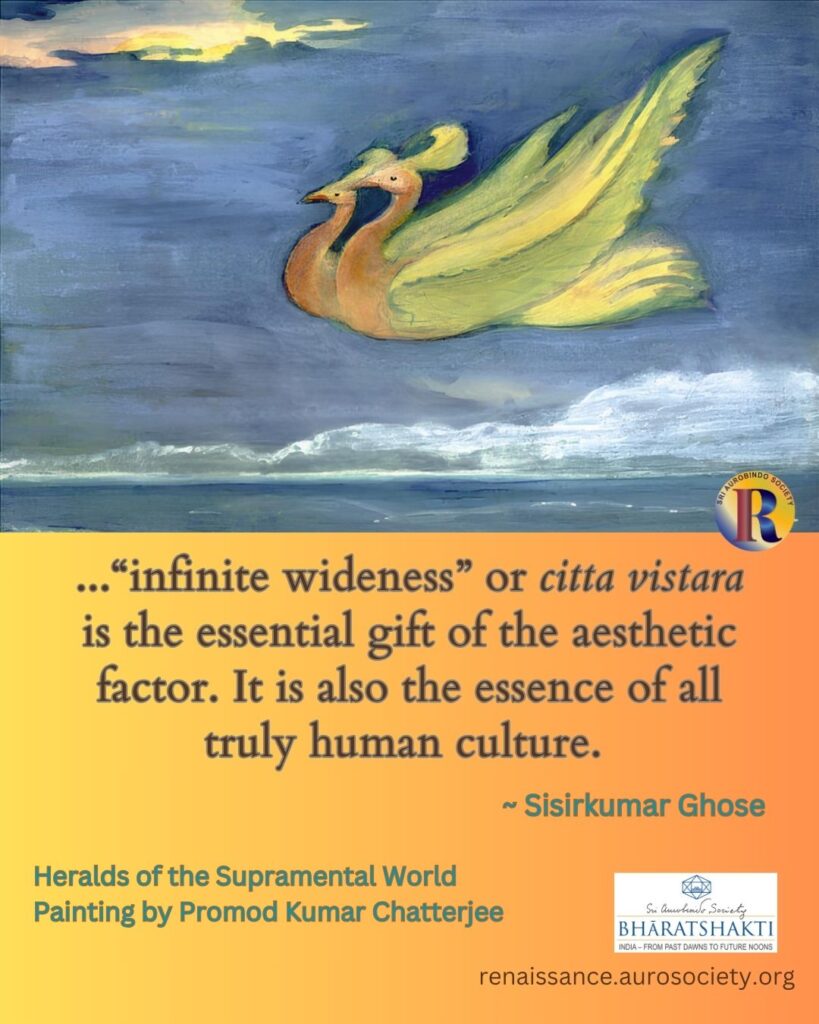
***
Thanks to the logic and language of our growing destiny the material sky, field of our troubled and mundane existence, is lit up with some word, hue, glory or passion from here or otherwhere. Then:
In an outbreak of the might of secret Spirit,
In Life and Matter’s answer of delight,
Some face of deathless beauty could be caught
That gave immortality to a moment’s joy,
Some word that could incarnate highest Truth
Leaped out from a chance tension of the soul,
Some hue of the Absolute could fall on life,
Some glory of knowledge and intuitive sight,
Some passion of the rapturous heart of Love.~ Sri Aurobindo, Savitri, pp. 175-176
Yet, it is remarkable, the great masters, old and new, speak but little of rules and techniques which seem to be all the cry today. Thus, if Sri Aurobindo refers but rarely to canons of art, or silpa sastras, like Manasara, Pratimalaksanam, Vishnudharmottaram and the like, it is not because he is unaware of their historical or technical importance but because he does not wish to be bound by the letter of the law. He does not legislate beauty’s form or manner of embodiment, he rather leaves the creative mystery a mystery, a dim analogue of the Creator’s mind :
A Mystery’s process is the universe…
Into its form the Child is ever born
Who lives for ever in the vasts of God,…Mirrored in the Inconscient’s boundless sleep,
Creation’s search for self began its stir.
A spirit dreamed in the crude cosmic whirl,
Mind flowed unknowing in the sap of life
And Matter’s breasts suckled the divine Idea.
A miracle of the Absolute was born;
Infinity put on a finite soul,
All ocean lived within a wandering drop,
A time-made body housed the Illimitable.
To live this Mystery out our souls came here.~ Sri Aurobindo, Savitri, The World-Stair
***
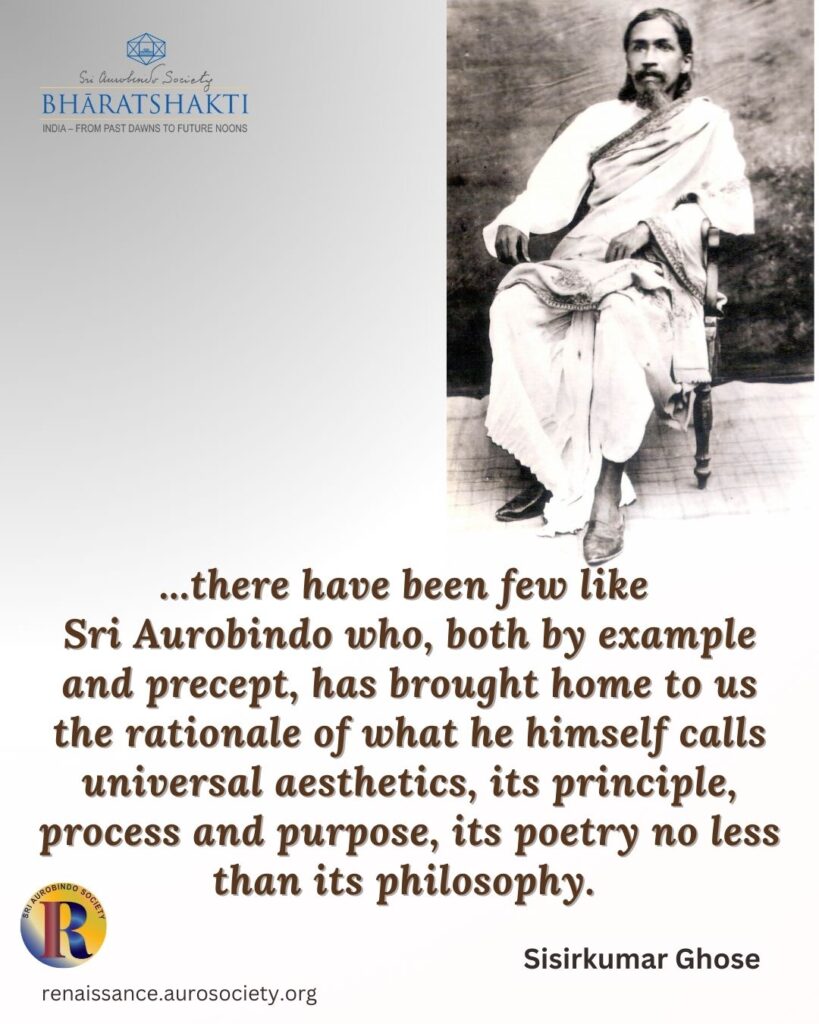
In the unfinished task, of making whole the fragment-being that we are, art and beauty are part of the mystery of inner life, “a self-luminous mystery” such as even our outer life and world might become one day:
A splendour of self-creation from the peaks,
A transfiguration in the mystic depths,
A happier cosmic working could begin
And fashion the world-shape in him anew,
God found in Nature, Nature fulfilled in God.~ Sri Aurobindo, Savitri, pp. 36-37
All told, there have been few like Sri Aurobindo who, both by example and precept, has brought home to us the rationale of what he himself calls universal aesthetics, its principle, process and purpose, its poetry no less than its philosophy. Here, indeed, is the best defence and justification of Indian culture on its side of aesthetic significance, by establishing the aesthetic principle right at the head of the ontological series, the cosmic process. One only wishes it could be embodied anew, on all levels of being and society.
That apart, it is of the essence of aesthetic experience to be shared. Thanks to our poet we too, as sahrdayas, may look into the life of forms and things, the creative moods of the Infinite:
One who has made in sport the suns and seas
Mirrors in our being his immense caprice.~ Sri Aurobindo, Lila, CWSA, Vol. 2, p. 611
Watch: Lila
***
But in the Aurobindonian view man is not only a mirror of the cosmos. He is one whose “nature grows,—His soul the dim bud of God’s flaming rose” (Sri Aurobindo, Man, the Mediator, CWSA, Vol. 2, p. 596). The call is the call of the self within, the creative daemon, and the rose is the rose of God, “great wisdom-bloom on the summits of being”.
Rose of God, great wisdom-bloom on the summits of being,
Rose of Light, immaculate core of the ultimate seeing!
Live in the mind of our earthhood; O golden Mystery, flower,
Sun on the head of the Timeless, guest of the marvellous Hour.~ Sri Aurobindo, Rose of God, CWSA, Vol. 2, p. 564
***
Only when we have learnt this Joyful Wisdom can we help “beauty conquer the resisting world” (Savitri, p. 55). This is a long way off, but this is what we are waiting for, the transformation of nature in “a perfect harmony combining in itself the integral development of our many-sided potentialities” (Sri Aurobindo, CWSA, Vol. 21, p. 229), and all life become a Hymn to Beauty. In our beginning is our end. In the words of Krishna Chaitanya, “The terminal of evolution is the same state of poetic relishing that initiated it”.
Beauty, angel of surplus,1 makes possible a more than biological adjustment, adds a new dimension to our life. Without art man would be “only an insect crawling among other ephemeral insects on a speck of surface mud and water which has managed to form itself amid the appalling immensities of the physical universe” (Sri Aurobindo, CWSA, Vol. 21, p. 48). It is the lasting value of Sri Aurobindo and of Indian aesthetics that it proposes a different and deeper reading of the human situation, saves us from the blight of disharmony, uglification and the general insignificance that is the lot of man today.
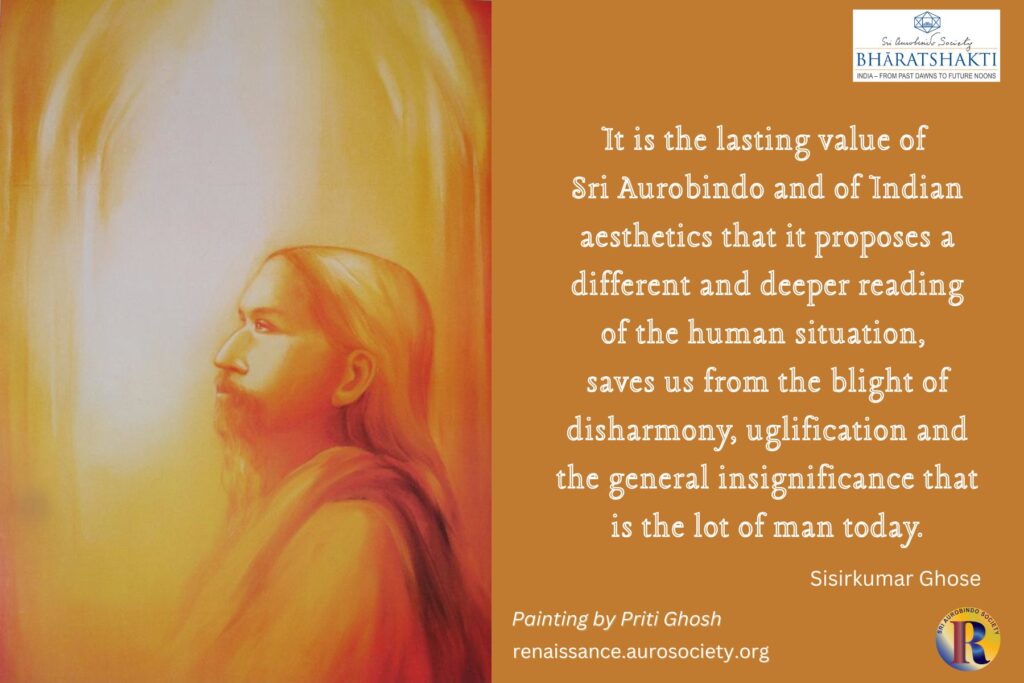
***
Notes
- The phrase is used by Rabindranath Tagore. ↩︎
***
~ Videos: Suhas Mehra <https://www.youtube.com/@matriwords>
~ Web Design: Beloo Mehra
CONCLUDED
Read previous parts – 1, 2


